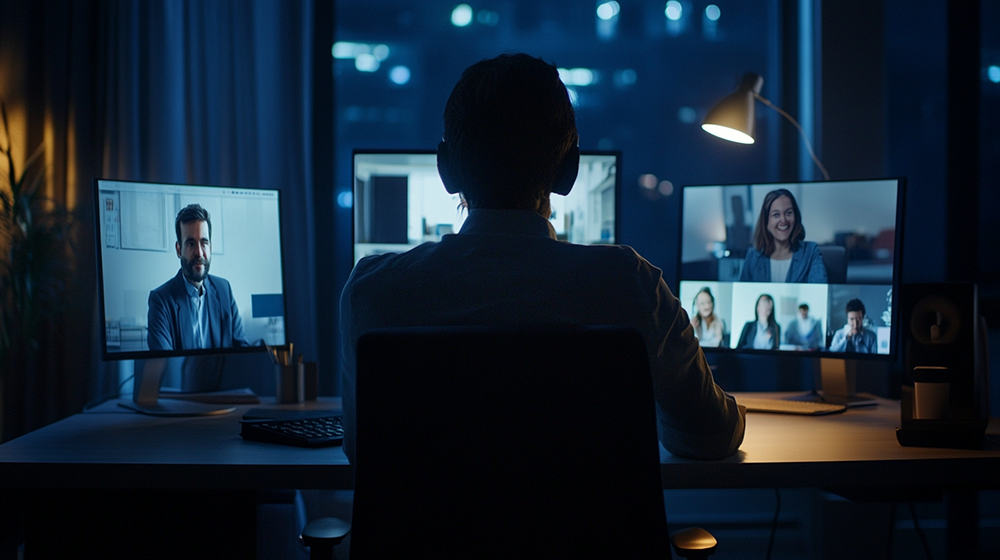The Global Shift to Virtual Learning
The rapid adoption of virtual learning, accelerated by the pandemic, has redefined the landscape of education and training. Virtual learning has become a powerful tool for bridging geographical divides and supporting professional development. One key element that has gained significant attention in these spaces is the use of personal video.
Did you know that over 70% of virtual learners feel more accountable when video is used, yet many still prefer to keep their cameras off?
This paradox reveals a deeper story about engagement in online spaces. While personal video can enhance engagement and communication, its overuse or misuse can lead to challenges such as Zoom fatigue and cognitive overload.
Often a highly debated topic, with people firmly in either the ‘cameras on’ or ‘cameras off’ camp, InSync Training carried out in-depth research to uncover answers about webcam usage in virtual learning environments. This article explores the the benefits, challenges, and best practices for personal video use, offering actionable recommendations for instructors to create more engaging and inclusive learning experiences.
Key Insights
- The Opportunity: Personal video enhances engagement, communication, and community in virtual learning when used thoughtfully.
- The Challenges: Overuse can cause fatigue, raise privacy concerns, and lead to disengagement.
- The Solution: Align video use with learning objectives (e.g., introductions, breakout sessions) and balance it with other tools like chat, polls, and whiteboards.
- Key Takeaway: Purposeful video use transforms virtual learning into a more engaging and inclusive experience.

Why Video Can Be Your Best Ally in Virtual Classrooms
Advantages of Personal Video in Virtual Classrooms
Personal video offers several benefits that enhance the virtual learning experience:
- Facilitates Non-Verbal Feedback and Improved Communication: Video allows instructors and learners to pick up on facial expressions and body language, enhancing understanding and interaction. For example, a facilitator can quickly gauge comprehension a concept by observing subtle cues, such as nods or puzzled expressions.
- Enhances Social Connection and Fosters a Sense of Community: Seeing peers and instructors on video helps learners feel more connected, reducing isolation—especially in remote and hybrid settings. Video-based activities like virtual scavenger hunts (see here for ideas) can provide highly engaging team-building experiences.
- Increases Learner Accountability and Engagement: Learners are more likely to stay focused and participate actively when they know they are visible on video. InSync Training’s research shows that 74% of learners believe video increases their sense of accountability during sessions.
The Hidden Pitfalls of Personal Video Use in Virtual Training
Despite its advantages, the use of personal video also presents notable challenges:
- Contributes to Zoom Fatigue and Cognitive Overload: Continuous video usage requires constant focus, which can lead to exhaustion and reduced cognitive performance. Research published in the Journal of Applied Psychology highlights that prolonged video use increases cognitive load and decreases productivity.
- Raises Privacy Concerns Among Learners: Not all learners feel comfortable sharing their personal space on camera. A caregiver working from home, for example, may feel uneasy revealing their environment. Facilitators can alleviate concerns by suggesting virtual backgrounds or allowing cameras-off options.
- Cultural Differences Impact Comfort with Video Use: In some cultures, maintaining privacy is deeply valued, making learners hesitant to turn on their cameras. Others may feel pressured to present themselves in a particular way, which can add stress or detract from learning. To foster inclusivity, instructors should allow culturally sensitive options such as blurred backgrounds and clarify that camera use is optional during certain parts of the session.
- Can Lead to Negative Perceptions or Disengagement When Overused: If video use isn't aligned with the session's objectives, learners may tune out—or even leave the session entirely. In fact, our research found that nearly 25% of learners find video distracting or feel it negatively impacts their ability to focus.

The Power of Purposeful Design
Aligning Video Use with Instructional Goals
The key to effective video use lies in its purposeful integration. Instructors must align video use with specific learning objectives, ensuring it enhances rather than hinders the experience. For instance:
- Introductions: Video fosters initial connections and builds rapport. Facilitators can enhance engagement and spark connections by encouraging discussions around objects in a learner’s background, such as a painting or virtual backdrop.
- Breakout Sessions: Video use in small groups encourages collaboration and active participation. Keeping cameras on during debrief discussions can lead to more meaningful insights and personal connections.
- Role-Playing Activities: Personal video adds authenticity and engagement to simulated scenarios. When learners practice skills that will be used in-person or on video calls, cameras-on becomes essential.
Apply InSync’s proven design and delivery skill set to your content with our Essential Starter Bundle: Learn More.
Research Findings from InSync Training
InSync Training’s research underscores the importance of intentional video usage:
- 89% of learners prefer video for targeted activities rather than continuous use.
- Continuous video usage negatively impacts learning outcomes, with learners reporting fatigue and distraction, leading to higher attrition rates.
- Purposeful and limited video use led to higher satisfaction and better engagement metrics, and therefore better learning outcomes.
 Recommendations and Practical Tips for Instructors
Recommendations and Practical Tips for Instructors
Strategies for Balanced Personal Video Use
Instructors can adopt the following strategies to strike the right balance:
- Use Video Strategically: Reserve video for key moments like introductions, collaborative exercises, and closing reflections. Avoid mandating continuous video use throughout the session.
- Be Flexible with Video Requirements: Allow learners the option to turn off their cameras during parts of the session to respect privacy and reduce fatigue.
- Elevate Your Virtual Presence: When you are on video, make sure your appearance communicates the impression you want to create. Dress appropriately (at least from the chest up), use a clean, professional background, and ensure proper webcam positioning for ‘eye contact.’
(Consider our Mastering Executive Presence workshop to really elevate your presence!)
Alternative Tools to Enhance Interaction
Personal video is just one tool in the virtual instructor’s toolbox. Combine it with other interactive features for a dynamic learning experience. For example, instead of relying on learners being on camera to nod or shake their head, ask them to choose a reaction such as a green check or red x. This way, you’ll see the reactions of everyone at the same time—no matter how many faces are on your screen.
- Chat: Allows for backchannel communication and quick check-ins.
- Polls and Quizzes: Gauge understanding and gather feedback in real-time.
- Whiteboards: Facilitate brainstorming and collaboration.
- Breakout Rooms: Promote small-group discussions without requiring constant video use.
- Integrated Learning Apps: Use tools like word clouds or advanced quizzes for deeper engagement.
These tools accommodate diverse groups of learners and ensure engagement without overwhelming them.
Modeling Appropriate Video Usage
During our research, we discovered that 82% of learners report echoing the instructor’s video behavior. As leaders of the virtual classroom, instructors should model best practices for video usage:
- Demonstrate Purposeful Use: Use video strategically to illustrate concepts, provide feedback, or facilitate discussions.
- Provide Clear Guidelines: Set expectations for learners regarding when and how to use their cameras. For example, clarify that video is encouraged during group activities but optional during lectures.
Join our February webinar for deeper insights into research-backed strategies for effective use of video in virtual learning: Register Now.
Harnessing the Power of Personal Video
When used effectively, personal video can significantly enhance virtual learning experiences by fostering accountability, supporting social connection, and improving communication. However, its potential drawbacks—fatigue, disengagement, and privacy concerns—necessitate a thoughtful approach.
By aligning video use with instructional goals and incorporating a variety of alternative tools, instructors can create a balanced and inclusive virtual learning environment. In an increasingly digital world, personal video isn’t just a tool—it’s a bridge that connects people, ideas, and possibilities. Use it wisely, and you’ll transform your virtual learning experiences into something truly unforgettable.
Schedule your free consultation today to discuss your virtual training needs:
Meet with an Expert (with your video on or off!)
 Karen Vieth
:
Feb 3, 2025 8:00:00 AM
Karen Vieth
:
Feb 3, 2025 8:00:00 AM



 Recommendations and Practical Tips for Instructors
Recommendations and Practical Tips for Instructors 

